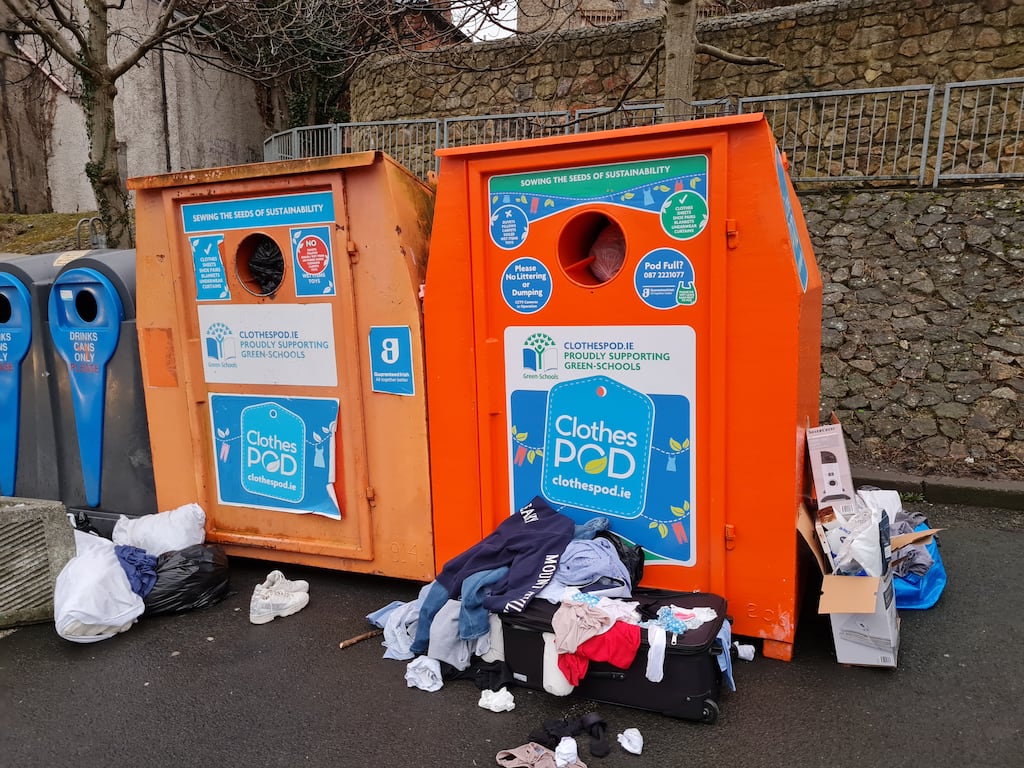Textile waste piling up at clothes banks across the State is challenging public’s expectations that their unwanted clothing is carefully recycled for reuse, say environmental groups.
The large, brightly coloured metal clothing banks in shopping centre car parks, outside filling stations, at civic amenity sites and GAA pitches are hard to ignore, particularly when stuffed full or with bags of unwanted clothes at their base.
While the locations might be convenient for many people, environmental charities are calling for more frequent collections from clothing banks and better regulation of the sector.
“Most of these banks are in parking lots at the mercy of the elements. They are often full of clothes literally overflowing the bank’s capacity, so it often ends up with items that are completely ruined before they are picked up by the bank’s operator,” said Solene Schirrer, project manager at Voice Ireland, an environmental NGO.
RM Block
At a recent meeting of Dundalk Municipal District, Councillor Emma Coffey said the failure of the owners of clothing banks to maintain them properly has contributed to the town’s poor results in the recent Irish Businesses Against Litter litter league.
“Louth County Council did an audit of clothing banks and removed some from local authority sites, but I think owners of the private property should be fined if there is illegal dumping next to clothing banks on their property,” she said.
In South Dublin, the Dodder Action group has posted photos of boxes and bags of clothing at the base of a Clothes Pod clothing bank at the public car park in Milltown a week after volunteers “forensically” cleaned up the area.
The environmental charity has been campaigning, without success, to have these clothing bins removed from close to the riverbank.
“This is a national issue, not a Dodder issue. Clothes Pod has over 1,000 clothing bins around the country, many on public land,” Victoria White, from Dodder Action, said.
Textile Recycling Limited, which operates Clothes Pod, did not respond an Irish Times request for information on the frequency of collection of textiles from the clothing banks it maintains.
However, on its website it claims to be the number one collector and exporter of second-hand clothing in Ireland with 1,200 “clothes pods” across the country.
“Each and every Clothes Pod is maintained efficiently as they are serviced on a regular and professional basis with the goal to prevent dumping of unfit clothing in landfill sites,” the company website states.
Dublin City Council (DCC) confirmed the service provider was responsible for servicing the banks and removing waste textile material while council cleaning staff were responsible for removing illegally dumped non-textile waste. The clothing banks on local authority sites in Dublin are operated under contract to DCC by Textile Recycling Limited.
“The majority of citizens recycle responsibly. Unfortunately, some choose to illegally dump their waste and there has been an increase in scavenging and discarding of materials around the city and indeed around the country in recent years,” the council said.
Clothing pods have been removed from two locations – East Wall and Glasnevin – in the city this year.
The Environmental Protection Agency estimates that clothes banks and charity shops collect and segregate about 35 per of consumer textile waste in the State. The rest is sorted through the domestic bins and sent for incineration.
[ Why our addiction to cheap, disposable clothing is an environmental disaster ]
In the State, we dispose of 164,000 tonnes of clothing waste a year, making us the second highest producer of textile waste in the EU. Only 6 per cent of so-called post-consumer textiles is reused here through charity shops, vintage stores and online second-hand platforms. Nine per cent of the material is recycled, mainly into rags and cleaning cloths, and 21 per cent is exported to the global second-hand market.
Since January 1, all EU member states have been obliged to set up separate collection systems for textile waste.
A report commissioned by the Department of the Environment and published last October found that illegal dumping and littering, contamination of textiles with non-textile materials, uneven regulation and transparency, limited recycling capacity and limited resources of clothing-bank operators were challenges facing the industry.
Voice Ireland is also concerned that the maintenance of clothing banks could decline further as commercial operators face poorer prices in the international second-hand textiles market.
“The international market for our castoffs has collapsed because there is simply too much waste,” said Schirrer, who leads the Fabric of Change campaign for Voice Ireland.
“The Ukraine war heavily impacted the route that European used clothes usually take as clothes were sent there for sorting, reuse and disposal before being exported again in the global south. At the same time, export markets, especially in Africa, are rejecting low-quality second-hand clothes labelled as reusable.”
There are also fears within the charity sector – which up to now has been willing to accept most donated clothing – that it will be inundated with higher volumes of poor-quality clothing if the EU legislation on separate collection systems for textile waste is fully enforced.
Charity shops are not waste disposal centres, Dermot McGilloway, national retail development manager at the St Vincent de Paul charity, told a recent circular economy conference in Dublin.
Where these mountains of discarded clothing end up is another concern of environmental charities. “Our local authorities are encouraging the dumping of clothes in clothes pods on their grounds, despite the fact that they are collected ineffectively and no one knows where the clothes go,” White said.
She said Dodder Action would no longer pick up clothes from around these clothes banks on their clean-up days.
Schirrer said that until the “Extended Producer Responsibility” system – where fashion brands help fund the cost of textile waste management – and sorting facilities were introduced in Europe for the reuse, resale and repurposing of textiles, then the problem of excessive amounts of clothing building up within the system would only get worse.
















